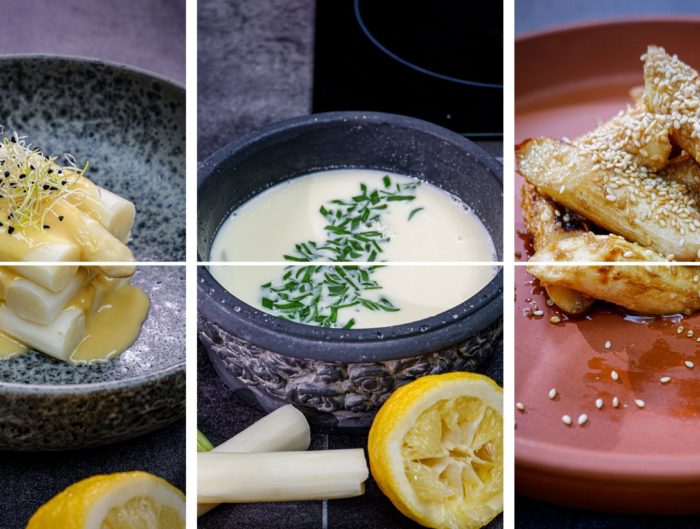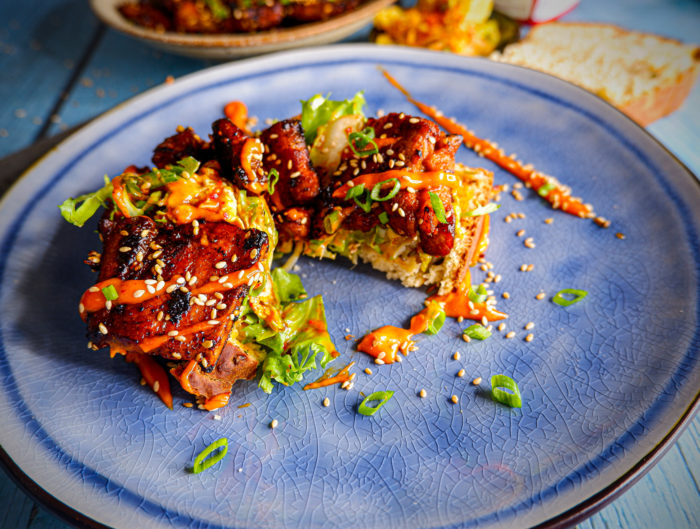
Goose n’Gyoza, red cabbage kimchi and teriyaki chestnuts
These three treats are a must every time you visit a restaurant that only nearly authenticates itself to Japanese cuisine. OK, strictly speaking, I don’t know in what form chestnuts get a menu authorization, but they just fit into the picture here. I had cooked a really tasty goose ramen in my last post. I would never pour myself in with hymns of praise, but the response was gigantic and the chosen try-out people of a smile were not upset. Bingo!
Nevertheless, ingredients and spices remained on the battlefield and for me as a chef it was a matter of honor to save these treats and instill a new personality in them. It wouldn’t be enough for a balanced Kaiseki, but it brought enough input to match the ingredients.
The fact that I haven’t created a Gyoza recipe yet triggers some displeasure. So the boiled goose leg provided the perfect base for the small dough bags.
Making a kimchi out of red cabbage was a little more difficult for me, because the structure of the red cabbage is unfortunately completely different from that of the Chinese cabbage. But hey.. Tasks are there to solve them.
Redefining the chestnut as a typical accompaniment to a local goose dinner was rather less difficult. If it is usually served with caramel in the local restaurants, it fits like a fist on the eye that soy takes on a leading task here. If you then add a light citrus note, it rounds off the whole number a little.

And that’s how it’s done. Ingredients:
| Goose gyoza for 4 persons: | for 4 people |
| 1 piece | Goose leg |
| 3 pieces | Garlic |
| 1 small piece ginger | Ginger |
| 1 Tbsp. | Miso (bright) |
| 1 Tbsp. | Red cabbage (also goes out of the glass) |
| Salt | |
| 1/2 tsp. Salt | Marjoram |
| 2 tbsp. | Goose sauce |
| 20 pieces | Wan Tan Leaves |
| Red cabbage kimchi | for 4 people |
| 1 head | Red cabbage |
| 100 g | Sugar (for pickling) |
| 100 g | Salt (for pickling) |
| 500 ml | Water |
| 5 tbsp. | Rice starch |
| 1 tsp. | Wild spice |
| 8 shares | Garlic |
| 1 thumb-sized piece | Ginger |
| 5 tbsp. | Fish sauce |
| 5 tbsp. | Rice vinegar |
| 4 tbsp. | Chili flakes |
| 3 tbsp. | Brown sugar |
| 2 tbsp. | Salt |
| Yakitori Maronen | for 4 people |
| 500 g | Chestnuts (peeled) |
| 100 g | Sugar |
| 200 ml | Apple juice |
| 100 ml | teriyaki sauce |
| peel of 1 | Orange |
| Sauce thickener | |
| Roasted sesame |


Delicious goose n’gyoza, red cabbage kimchi and teriyaki chestnuts Guide:
Goose Gyoza
For the goose gyoza I cooked the goose legs softly until the meat almost fell off the bone. I then processed the plucked meat into a fine mass with red cabbage, ginger, marjoram, garlic and miso. If you add a spoonful of strong goose sauce, you’ll definitely be driving right. Then I laid out circular Wantan leaves and filled them with the mass. You can also make the dough yourself. It consists only of flour, salt and water. Simply beat the leaves together like a ravioli and gently press them. Water is enough to glue. The Gyoza are briefly fried from both sides until they are golden brown. Then you remove it with a sip of water and quickly put a lid on it. After another minute under water vapor, they are already ready to serve.
Red cabbage kimchi
For the kimchi, cut the cabbage into fine strips. Afterwards, these are sugared and salted. Leave them covered overnight and stand outside at room temperature. The next day, you wash the cabbage strips and put them aside for the time being. Next, bring a pot of water and wild spice to the boil. Bind the water with rice starch and allow it to cool. In the meantime, mix garlic, ginger, chili flakes, brown sugar, fish sauce, salt and some traveling vinegar into a marinade. Mix it with the starchy water and generously marinate the red cabbage. Leave the kimchi mixture outside at least one day, covered, at room temperature. After at least one day, the kimchi is ready. You can also leave it standing longer. That makes it more intense.

teriyaki chestnuts with roasted sesame
For this I took peeled, pre-cooked chestnuts. Of course, you can also pre-cook the chestnuts fresh and then roast them. This is certainly a little more smoky. However, I have opted for a more lenient option. Caramelize the sugar in a saucepan and quench with apple juice. Bring to the boil and add the chestnuts. Swing them once and then wipe them off with the teriyaki sauce. You get it in the Japanese supermarket or just do it yourself. (it consists of soy sauce, sweet rice wine, sake, sugar, ginger, lime juice and garlic). Otherwise you can also take Ponzu. Cook the chestnuts once in the brew and then bind them with sauce binder. You can also add some orange abrasion. It’s all a bit freshening up. The sauce should settle nicely around the chestnuts. Put them in a bowl and sprinkle with toasted sesame.



